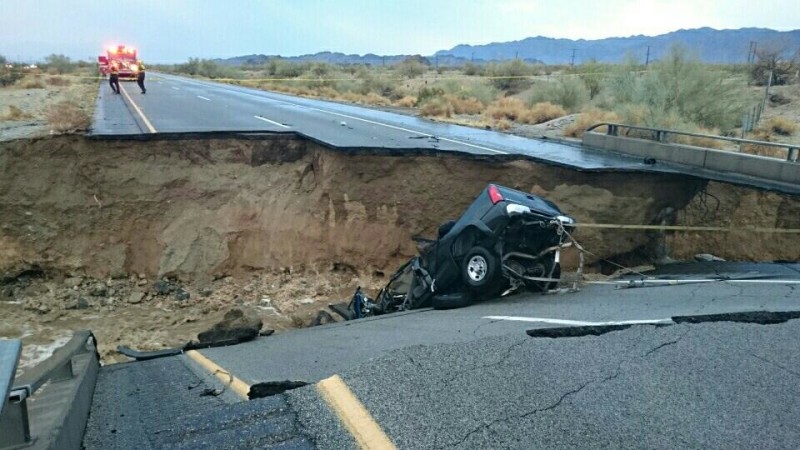The eastbound bridge gave way just after 4:30 p.m., with the structure ending up in the roaring torrent below.
The westbound section of the freeway was also closed. The roadway was intact but extremely undermined by flooding and could need just-as-extensive rebuilding, Terri Kasinga, a Caltrans spokeswoman.
One driver had to be rescued from a pickup that crashed in the collapse and was taken to a hospital with moderate injuries, the Riverside County Fire Department said.
Hundreds of other cars were stranded immediately after the collapse, but the California Highway Patrol worked to divert them and it wasn't clear if any remained, Kasinga said.
No time frame was given for when either side of the freeway would reopen as Caltrans examines the site.
Transportation officials recommended westbound travelers on the Arizona side of the collapse use U.S. 95, from Quartzsite, on I-10, to Yuma, on I-8; on the west side of the demolished bridge, eastbound travelers were advised to use state Highways 86 or 111 to detour from Coachella, on I-10, to El Centro, on I-8.
Each of those detours would add 160 or so miles to the normal 375-mile trip from L.A. to Phoenix on I-10.
Rain fell Sunday afternoon in parts of Los Angeles County's mountains, the valley north and inland urban areas to the east as remnants of tropical storm Dolores brought warm, muggy conditions northward.
The showers forced the Los Angeles Angels' first rainout in 20 years and the San Diego Padres' first rainout since 2006.
Saturday's rainfall broke records in at least 11 locations, including five places that had the most rain ever recorded on any day in July, said National Weather Service meteorologist Joe Sirard.
July is typically the driest month of the year in Southern California. Because of that, Saturday's 0.36 inch of rain in downtown Los Angeles exceeded the 0.24 inch recorded July 14, 1886, which had been the wettest July day in nearly 130 years.
Ramona in San Diego County received 4.1 inches of rain in the 48 hours ending at 7 p.m. Sunday, while Pinyon Pines in Riverside County got 3.28 inches. Running Springs and Lake Arrowhead in the San Bernardino Mountains had more than 2½ inches, while Kearny Mesa in San Diego received 2.39 inches.
Besides the flash floods, the storm brought power outages and turned Los Angeles County's typically packed coast into empty stretches of sand when the threat of lightning forced authorities to close 70 miles of beaches.
The summer storm has helped firefighters advance on two wildfires that broke out Friday, including one that forced the closure of another key Southern California freeway.
Interstate 15 in the mountainous Cajon Pass northeast of Los Angeles was shut down after flames swept across lanes, torching vehicles and sending people running for safety. All lanes were open Monday on the main artery between Southern California and Las Vegas, and the blaze was 75 percent contained.
AP Writer Chris Weber in Los Angeles contributed to this story.

